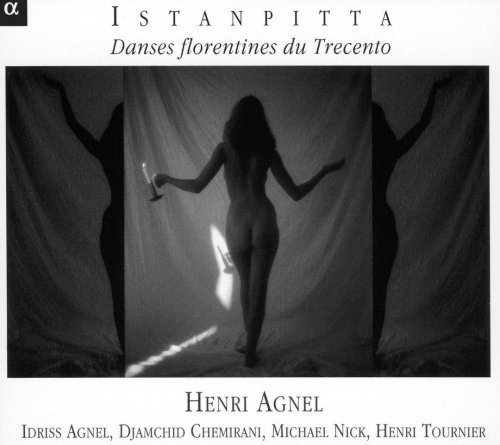Henri Agnel - Istanpitta: Danses florentines du Trecento (2004) CD-Rip

Artist: Henri Agnel
Title: Istanpitta: Danses florentines du Trecento
Year Of Release: 2004
Label: Alpha
Genre: Classical
Quality: WAVPack (image+.cue,log,scans)
Total Time: 57:09
Total Size: 391 Mb
WebSite: Album Preview
Tracklist: Title: Istanpitta: Danses florentines du Trecento
Year Of Release: 2004
Label: Alpha
Genre: Classical
Quality: WAVPack (image+.cue,log,scans)
Total Time: 57:09
Total Size: 391 Mb
WebSite: Album Preview
1.Istanpitta Tristano & Manfredina: (6:30)
Prélude de flute;
Lamento de Tristano (anonyme)
Lamento de la Manfredina (anonyme)
Rotta de Tristano (anonyme)
Rotta de la Manfredina (anonyme)
2.Istanpitta Ghaetta: (12:23)
Prélude de cistre;
Prélude Ghaetta (Henri Agnel);
Ghaetta (anonyme);
Sento d'amor la Flamma (Gregorio Calonista)
3.Istanpitta In Pro: (6:05)
Prélude de quinton,
In Pro (anonyme);
4.Istanpitta Chanconetta Tedescha: (5:01)
Prélude de ceterina;
Chanconetta Tedescha (anonyme);
5.Istanpitta Saltarello: (3:43)
Prélude de flûte;
Saltarello à 4 temps (anonyme);
6.Istanpitta Saltarello & Trotto: (7:02)
Prélude de zarb;
Saltarello à 5 temps (anonyme);
Trotto (anonyme);
7.Istanpitta Isabella: (6:34)
Prélude de oud;
Isabella (anonyme);
8.Istanpitta Tre Fontana: (5:06)
Prélude de quinton;
Tre Fontana (anonyme);
9.Istanpitta Saltarello: (4:22)
Prélude de ceterina, quinton & flûte;
Saltarello à 6 temps(anonyme);
Performers:
Henri Agnel (cistre, ceterina, oud, arrangements & direction)
Michael Nick (quinton)
Djamchid Chemirani (zarb)
Henri Tournier (flûte traversière, bansouri)
Idriss Agnel (oud)
In some respects, this is a commendable recording of 14th-century Florentine istanpitte. The performances are vibrant and the acoustic is masterfully captured by Alpha. Henri Agnel, the ensemble director, plays with verve, and the occasional technical edges in the ensemble playing are compensated for by interpretations which are almost always aesthetic.
Yet for the listener with even a vague interest in historical integrity, this CD must come with a precautionary warning...
The ensemble set-up results not from research into combinations heard in the milieu of the Visconti residences c.1380-1400, but from rather a more spontaneous, haphazard approach: variously heard are an Indian flute, gatam and quinton, Iranian zarb, Brazilian oudou, Arabic oud, medieval ceterina and Renaissance cittern...
Additionally, Agnel's accompanying liner notes are, at times, an exasperating read. He justifies the ensemble on the basis that 'monophonic art is open to all instruments', makes large generalizations (referring to the troubadours, the Indian 'ghazal' and jazz), and scoffs at the quest for authenticity ('practising medieval music only as a historical reconstitution...rigidifies it'). Yet this attitude raises questions about the validity of Agnel labelling his interpretations as 'danses florentines du Trecento'. For example, track 4 (one of the four surviving chanconete tedesche) was not designed as a melody in itself, but appears to have been a tenor over which an improvised superius would have been added, and was a composition most likely to have been played by an alta ensemble. Similarly, Calonista's ballata (end of track 2) is philosphically, contextually, melodically and structurally distinct from the istanpitte, salterelli or other instrumental works here presented. Agnel's emphasis on improvisation - which, although mostly successful aesthetically, is sometimes very expansive - also distracts from the structure of the original melodies (the 5:30 minutes introduction to Istanpitta Ghaetta and the 3:00 minutes zarb prelude to track 6 are pertinent examples).
In short, this CD presents atmospheric interpretations of the istanpitte (in amongst substantial improvisation), although the results are achieved somewhat at the expense of academia. As performances in themselves, they are enjoyable enough, but regarding the scholarship...you have been warned!!
Yet for the listener with even a vague interest in historical integrity, this CD must come with a precautionary warning...
The ensemble set-up results not from research into combinations heard in the milieu of the Visconti residences c.1380-1400, but from rather a more spontaneous, haphazard approach: variously heard are an Indian flute, gatam and quinton, Iranian zarb, Brazilian oudou, Arabic oud, medieval ceterina and Renaissance cittern...
Additionally, Agnel's accompanying liner notes are, at times, an exasperating read. He justifies the ensemble on the basis that 'monophonic art is open to all instruments', makes large generalizations (referring to the troubadours, the Indian 'ghazal' and jazz), and scoffs at the quest for authenticity ('practising medieval music only as a historical reconstitution...rigidifies it'). Yet this attitude raises questions about the validity of Agnel labelling his interpretations as 'danses florentines du Trecento'. For example, track 4 (one of the four surviving chanconete tedesche) was not designed as a melody in itself, but appears to have been a tenor over which an improvised superius would have been added, and was a composition most likely to have been played by an alta ensemble. Similarly, Calonista's ballata (end of track 2) is philosphically, contextually, melodically and structurally distinct from the istanpitte, salterelli or other instrumental works here presented. Agnel's emphasis on improvisation - which, although mostly successful aesthetically, is sometimes very expansive - also distracts from the structure of the original melodies (the 5:30 minutes introduction to Istanpitta Ghaetta and the 3:00 minutes zarb prelude to track 6 are pertinent examples).
In short, this CD presents atmospheric interpretations of the istanpitte (in amongst substantial improvisation), although the results are achieved somewhat at the expense of academia. As performances in themselves, they are enjoyable enough, but regarding the scholarship...you have been warned!!
![Xavi Torres - Amsterdam Magic (2025) [Hi-Res] Xavi Torres - Amsterdam Magic (2025) [Hi-Res]](https://www.dibpic.com/uploads/posts/2025-12/1766061682_cover.jpg)
![NYO Jazz - Live in Johannesburg (Live) (2025) [Hi-Res] NYO Jazz - Live in Johannesburg (Live) (2025) [Hi-Res]](https://www.dibpic.com/uploads/posts/2025-12/1765894703_zwp14vk90corb_600.jpg)




![Sibel Köse Septet - In Good Company (2025) [Hi-Res] Sibel Köse Septet - In Good Company (2025) [Hi-Res]](https://www.dibpic.com/uploads/posts/2025-12/1765846644_uizwujac4ht2d_600.jpg)
![Eshon Burgundy - Safe Place (Bossa Nova Jazz) (2025) [Hi-Res] Eshon Burgundy - Safe Place (Bossa Nova Jazz) (2025) [Hi-Res]](https://www.dibpic.com/uploads/posts/2025-12/1766079194_cover.jpg)
